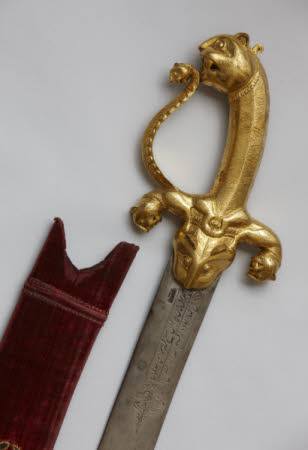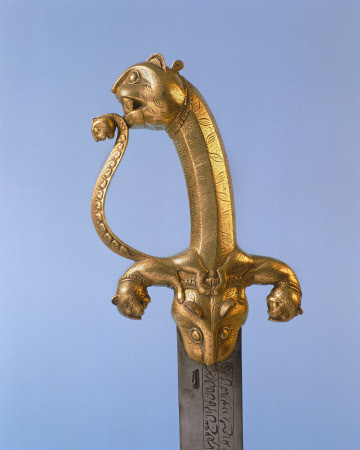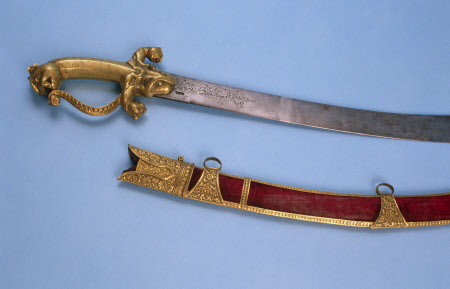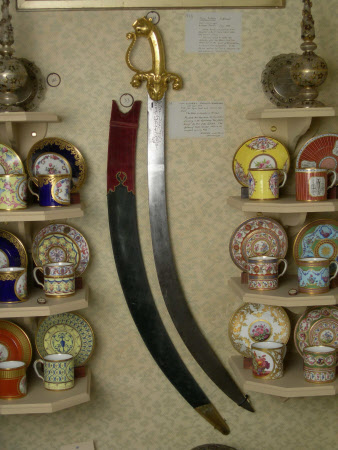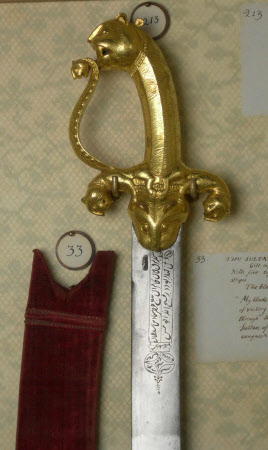Sword
Category
Arms and armour
Date
1782 - 1799
Materials
Steel copper and gilt
Measurements
775 mm (L)
Place of origin
Mysuru (Mysore)
Order this imageCollection
Powis Castle and Garden, Powys
NT 1180589.1
Summary
Steel sword, made between 1782 and 1799 in Mysuru (formerly known as Mysore), India. Gilded copper hilt with pommel, langets and knuckle guard terminal modelled as tiger heads, and quillons as crouching tigers. All these parts, along with the grip, decorated with lightly-incised tiger stripes. The single-edged steel blade is curved, and inscribed and stamped with a Persian distich/couplet and a cartouche containing the names of God, the prophet Muhammad, and the ruler of Mysuru, Tipu Sultan (1750-1799). This sword is associated with Tipu Sultan (1750-99), the ruler of Mysuru (formerly known as Mysore). Tipu Sultan succeeded his father as ruler of the South Indian state of Mysuru in 1782, where he built a sophisticated court around his palace at Srirangapatna (formerly known as Seringapatam).
Full description
Tipu was a powerful ruler whose reign was characterised by military conflict and reform. During his 17-year reign, Tipu introduced direct revenue collection, changes to land ownership, investment in agriculture and industrialisation, and social reforms. He also supported the establishment of factories and trading companies beyond Mysuru and the immigration of skilled foreign workers in order to develop local capability to produce modern firearms [Satyanarayana, p. 2245-7]. Tipu associated himself with a tiger motif, a powerful emblem in pre-colonial India. Many items associated with Tipu bear representations of tigers and tiger stripes, including arms, coins, book bindings, and eight tiger-head finials from his throne [Brittlebank, p. 258-9]. One finial was acquired by Edward and Henrietta Clive after the sack of Srirangapatna in 1799 [NT 1180713]. The five tigers and lightly incised tiger stripe motif on the hilt of this sword; the inscription of Tipu Sultan’s name on the blade; and the names of God, the Prophet Muhammad, the first Caliphs recognised by the Sunnis, link this sword to Srirangapatna. A Persian couplet, also on the blade, names Haydar. This is a reference to Ali, cousin to the prophet Muhammad, who was nicknamed ‘Haydar’, which means ‘lion’ in Arabic, but also to Tipu’s father, Hyder Ali. Unlike a very similar sabre in the Royal Collection [RCIN 67216], the tiger terminals on this sword do not have jewelled eyes. Research Note on Provenance Tipu Sultan spent much of his reign engaged in the defence of Mysuru against encroachment by the British East India Company. In 1798, a renewed British campaign provoked the Fourth Anglo-Mysore War. On 4th May 1799, during the Siege of Srirangapatna, Tipu was killed. In the immediate aftermath, the British army looted the town. According to Colonel Arthur Wellesley, later the Duke of Wellington, ‘Scarcely a house in the town was left unplundered, and I understand that in camp jewels of the greatest value, bars of gold etc etc have been offered for sale in the bazaars of the army by our soldiers, sepoys and followers. I came in to take command of the army on the morning of the 5th and with the greatest exertion, by hanging, flogging etc etc in the course of that day I restored order…’ [Dalrymple, p. 351]. The resumption of control by the higher ranks of the army enabled the work of the prize committee to begin. Prize committees were responsible for ‘collecting, inventorying and disposing of booty seized from the enemy and for …seeking to establish combatants’ entitlement to prize' [Finn, p.17]. They were intended to prevent the kind of undisciplined plunder which Wellesley reported in the aftermath of Tipu’s defeat at Srirangapatna. More than 1,000 commissioned officers took their allotted share in the captured property, which they kept, exchanged or sold to others. High value, or high-profile items, were excluded from the prize committee’s remit, and given to senior civil and military personnel, as well as the British royal family. Not all articles were genuine: tenuous or spurious attributions to Tipu Sultan have been identified in objects which were brought to Britain. Recent work on a sword at the Wallace Collection [OA1402] has shown that an inscription on the blade suggesting personal ownership by Tipu was added after his death in 1799. A letter to Edward Clive (1754-1839), then Governor of Madras (1798-1803), may refer to this sword, shedding light on how it reached Powis Castle. On 10th September 1803, Lieutenant Colonel James Brunton, Military Auditor General in Madras, described 'a ...Sword which was the property of the late Sultan of Mysore procured for me at the Sale of his effects by one of the Prize Agents, as it is genuine, and a Curiosity, Your Lordship may be pleased to possess it.' [Archer et al, p.47]
Provenance
Accepted by HM Treasury on 21st March, 1963 in lieu of tax and conveyed to National Trust ownership on 29th November 1963.
Marks and inscriptions
Where blade joins hilt: Incised in Persian: Shud barq-i jān-i kāfarā[n] tīgh-i ẓafar buniyād-i man Sultān-i dīn Haydar buva[d] dar Fatḥᵉ bar imdād [?]-i man Translated: My blade that lays down the foundations of victory is the lightning that flashes through the lives of the infidels The sultan of faith Haydar relies in his conquests upon my help. [Transcription and translation from Archer et al, Treasures from India, p.47] Proceeding down the blade towards the point:: Cartouche containing the name of Tipu Sultan. A rosette, the names of God and the prophet Muhammad, surrounded by the names of the first Caliphs recognised by the Sunnis. [Information from Treasures from India, p. 47]
References
2019 Dalrymple: W Dalrymple, The Anarchy: The Relentless Rise of the East India Company, Bloomsbury 2019 2018 Finn: Margot Finn, ‘Material Turns in British History I: Loot’, Transactions of the Royal Historical Society, Vol. 28, December 2018 2004 Satyanarayana: A Satyanarayana ‘Review: The Mysore Sultans. State and Diplomacy under Tipu Sultan: Documents and Essays by Irfan Habib’ Economic and Political Weekly 39 24 (2004) 1995 Brittlebank: K Brittlebank, ‘Sakti and Barakat: The Power of Tipu’s Tiger. An Examination of the Tiger Emblem of Tipu Sultan of Mysore’, Modern Asian Studies 29 2 (1995) Archer, Rowell and Skelton 1987 Mildred Archer, Christopher Rowell, and Robert Skelton, Treasures from India: The Clive Collection at Powis Castle, London, 1987
